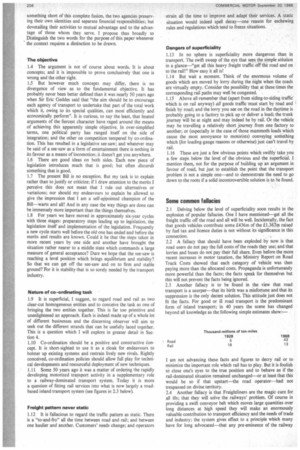The objective
Page 212

If you've noticed an error in this article please click here to report it so we can fix it.
1.4 The argument is not of course about words. It is about concepts; and it is impossible to prove conclusively that one is wrong and the other right.
1.5 But however much concepts may differ, there is no divergence of view as to the fundamental objective. It has probably never been better defined than it was nearly 50 years ago when Sir Eric Geddes said that "the aim should be to encourage each agency of transport to undertake that part of the total work which it, owing to its special qualities, can most efficiently and economically perform". His curious, to say the least, that heated arguments of the fiercest character have raged around the means of achieving this apparently simple objective. In over-simplified terms, one political party has ranged itself on the side of integration; and the other on competition tempered by co-ordination. This has resulted in a legislative see-saw; and whatever may be said of a see-saw as a form of entertainment there is nothing in its favour as a means of locomotion; it doesn't get you anywhere. 1.6 There are good ideas on both sides. Each new piece of legislation introduces much that is good; but often discards something that is good.
1.7 The present Bill is no exception. But my task is to explain rather than to justify or criticize; if I draw attention to the merits I perceive this does not mean that I rule out alternatives or variations; nor should my endeavours to explain be allowed to give the impression that I am a self-appointed champion of the Bill—warts and all! And in any case the way things are done can be immensely more important than the things themselves.
1.8 For years we have moved in approximately six-year cycles with three stages: preparatory steps leading up to legislation, the legislation itself and implementation of the legislation. Frequently a new cycle starts well before the old one has ended and before the merits and results are known. Could it be that the steps taken in more recent years by one side and another have brought the situation rather nearer to a middle state which commands a large measure of general acceptance? Dare we hope that the see-saw is reaching a level position which brings equilibrium and stability? So that we can get off the see-saw and on to firm and stable ground? For it is stability that is so sorely needed by the transport industry.


















































































































































































































































































































































































